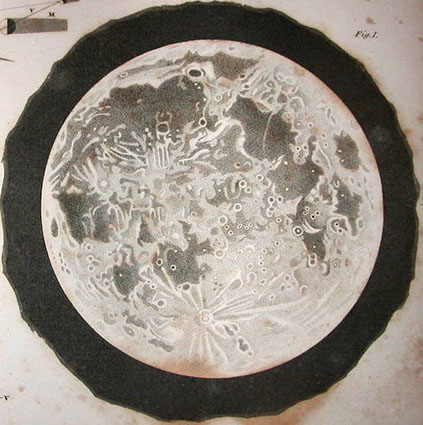Difference between revisions of "October 18, 2004"
| Line 12: | Line 12: | ||
</table> | </table> | ||
<table width="80%" border="0" align="center" cellpadding="8"> | <table width="80%" border="0" align="center" cellpadding="8"> | ||
| − | <tr><td><div align="center" class="main_sm">Image Credit: [chuck@observingthesky.org Chuck Wood]</p> | + | <tr><td><div align="center" class="main_sm"><p>Image Credit: [chuck@observingthesky.org Chuck Wood]</p> |
</div></td> | </div></td> | ||
</tr> | </tr> | ||
| Line 21: | Line 21: | ||
<p align="left">I did it again. I bought another lunar map on eBay. This one was printed in London in 1826 and apparently was from an encyclopedia or some similar work. I hate it when books are disassembled to sell the plates - but I love the old lunar maps! The left side of the engraving contains illustrations of lunar shadows, phases and eclipses but the glory of the plate is the large full Moon drawing, shown here. In general, almost every lunar map made in the 1700s and early 1800s was a copy of one of the few original telescope-based drawing made by Hevelius or Grimaldi. But this particular drawing seems to be based on the 1805 engraving of the full Moon by the British artist John Russell (see Whitaker's <i>Mapping and Naming of the Moon,</i> p 99). Russell's map had more details, and the copier mimicked the general patterns but simplified. In fact, the simplification went so far that Copernicus has disappeared from the copy, even though it is clearly shown by Russell. It is ironic that this is a degraded copy of Russell's map, because Russell was inspired to make his very accurate map because of the very poor quality maps commonly reproduced in books!</p> | <p align="left">I did it again. I bought another lunar map on eBay. This one was printed in London in 1826 and apparently was from an encyclopedia or some similar work. I hate it when books are disassembled to sell the plates - but I love the old lunar maps! The left side of the engraving contains illustrations of lunar shadows, phases and eclipses but the glory of the plate is the large full Moon drawing, shown here. In general, almost every lunar map made in the 1700s and early 1800s was a copy of one of the few original telescope-based drawing made by Hevelius or Grimaldi. But this particular drawing seems to be based on the 1805 engraving of the full Moon by the British artist John Russell (see Whitaker's <i>Mapping and Naming of the Moon,</i> p 99). Russell's map had more details, and the copier mimicked the general patterns but simplified. In fact, the simplification went so far that Copernicus has disappeared from the copy, even though it is clearly shown by Russell. It is ironic that this is a degraded copy of Russell's map, because Russell was inspired to make his very accurate map because of the very poor quality maps commonly reproduced in books!</p> | ||
<blockquote> | <blockquote> | ||
| − | <p align="right">— [mailto:tychocrater@yahoo.com Chuck Wood]</blockquote> | + | <p align="right">— [mailto:tychocrater@yahoo.com Chuck Wood]</p></blockquote> |
<p align="left"><b>Related Links:</b><br> | <p align="left"><b>Related Links:</b><br> | ||
[http://www.getty.edu/art/collections/bio/a18318-1.html The Artist John Russell] | [http://www.getty.edu/art/collections/bio/a18318-1.html The Artist John Russell] | ||
| + | </p> | ||
<p align="left"><b>Tomorrow's LPOD: </b> Rays of Light</p> | <p align="left"><b>Tomorrow's LPOD: </b> Rays of Light</p> | ||
</tr> | </tr> | ||
Revision as of 20:50, 17 January 2015
1826 Moon
Image Credit: [chuck@observingthesky.org Chuck Wood] |
|
1826 Moon I did it again. I bought another lunar map on eBay. This one was printed in London in 1826 and apparently was from an encyclopedia or some similar work. I hate it when books are disassembled to sell the plates - but I love the old lunar maps! The left side of the engraving contains illustrations of lunar shadows, phases and eclipses but the glory of the plate is the large full Moon drawing, shown here. In general, almost every lunar map made in the 1700s and early 1800s was a copy of one of the few original telescope-based drawing made by Hevelius or Grimaldi. But this particular drawing seems to be based on the 1805 engraving of the full Moon by the British artist John Russell (see Whitaker's Mapping and Naming of the Moon, p 99). Russell's map had more details, and the copier mimicked the general patterns but simplified. In fact, the simplification went so far that Copernicus has disappeared from the copy, even though it is clearly shown by Russell. It is ironic that this is a degraded copy of Russell's map, because Russell was inspired to make his very accurate map because of the very poor quality maps commonly reproduced in books! Related Links: Tomorrow's LPOD: Rays of Light |
|
Author & Editor: Technical Consultant: Contact Translator: A service of: |
COMMENTS?
Register, and click on the Discussion tab at the top of the page.




